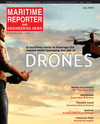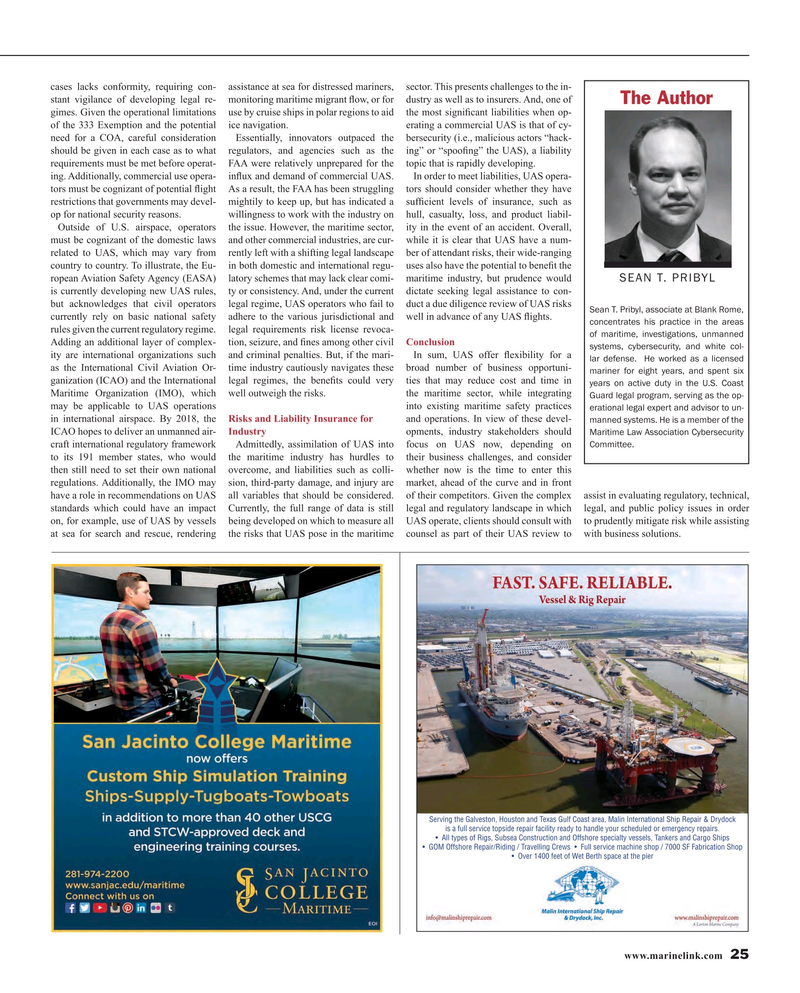
Page 25: of Maritime Reporter Magazine (July 2016)
Marine Communications Edition
Read this page in Pdf, Flash or Html5 edition of July 2016 Maritime Reporter Magazine
cases lacks conformity, requiring con- assistance at sea for distressed mariners, sector. This presents challenges to the in- stant vigilance of developing legal re- monitoring maritime migrant ? ow, or for dustry as well as to insurers. And, one of
The Author gimes. Given the operational limitations use by cruise ships in polar regions to aid the most signi? cant liabilities when op- of the 333 Exemption and the potential ice navigation. erating a commercial UAS is that of cy- need for a COA, careful consideration Essentially, innovators outpaced the bersecurity (i.e., malicious actors “hack- should be given in each case as to what regulators, and agencies such as the ing” or “spoo? ng” the UAS), a liability requirements must be met before operat- FAA were relatively unprepared for the topic that is rapidly developing. ing. Additionally, commercial use opera- in? ux and demand of commercial UAS. In order to meet liabilities, UAS opera- tors must be cognizant of potential ? ight As a result, the FAA has been struggling tors should consider whether they have restrictions that governments may devel- mightily to keep up, but has indicated a suf? cient levels of insurance, such as op for national security reasons. willingness to work with the industry on hull, casualty, loss, and product liabil-
Outside of U.S. airspace, operators the issue. However, the maritime sector, ity in the event of an accident. Overall, must be cognizant of the domestic laws and other commercial industries, are cur- while it is clear that UAS have a num- related to UAS, which may vary from rently left with a shifting legal landscape ber of attendant risks, their wide-ranging country to country. To illustrate, the Eu- in both domestic and international regu- uses also have the potential to bene? t the ropean Aviation Safety Agency (EASA) latory schemes that may lack clear comi- maritime industry, but prudence would
SEAN T. PRIBYL is currently developing new UAS rules, ty or consistency. And, under the current dictate seeking legal assistance to con- but acknowledges that civil operators legal regime, UAS operators who fail to duct a due diligence review of UAS risks
Sean T. Pribyl, associate at Blank Rome, currently rely on basic national safety adhere to the various jurisdictional and well in advance of any UAS ? ights.
concentrates his practice in the areas rules given the current regulatory regime. legal requirements risk license revoca- of maritime, investigations, unmanned
Adding an additional layer of complex- tion, seizure, and ? nes among other civil Conclusion systems, cybersecurity, and white col- ity are international organizations such and criminal penalties. But, if the mari- In sum, UAS offer ? exibility for a lar defense. He worked as a licensed as the International Civil Aviation Or- time industry cautiously navigates these broad number of business opportuni- mariner for eight years, and spent six ganization (ICAO) and the International legal regimes, the bene? ts could very ties that may reduce cost and time in years on active duty in the U.S. Coast
Maritime Organization (IMO), which well outweigh the risks. the maritime sector, while integrating
Guard legal program, serving as the op- may be applicable to UAS operations into existing maritime safety practices erational legal expert and advisor to un- in international airspace. By 2018, the Risks and Liability Insurance for and operations. In view of these devel- manned systems. He is a member of the
ICAO hopes to deliver an unmanned air- Industry opments, industry stakeholders should
Maritime Law Association Cybersecurity
Committee.
craft international regulatory framework Admittedly, assimilation of UAS into focus on UAS now, depending on to its 191 member states, who would the maritime industry has hurdles to their business challenges, and consider then still need to set their own national overcome, and liabilities such as colli- whether now is the time to enter this regulations. Additionally, the IMO may sion, third-party damage, and injury are market, ahead of the curve and in front have a role in recommendations on UAS all variables that should be considered. of their competitors. Given the complex assist in evaluating regulatory, technical, standards which could have an impact Currently, the full range of data is still legal and regulatory landscape in which legal, and public policy issues in order on, for example, use of UAS by vessels being developed on which to measure all UAS operate, clients should consult with to prudently mitigate risk while assisting at sea for search and rescue, rendering the risks that UAS pose in the maritime counsel as part of their UAS review to with business solutions.
Serving the Galveston, Houston and Texas Gulf Coast area, Malin International Ship Repair & Drydock is a full service topside repair facility ready to handle your scheduled or emergency repairs. s

 24
24

 26
26
